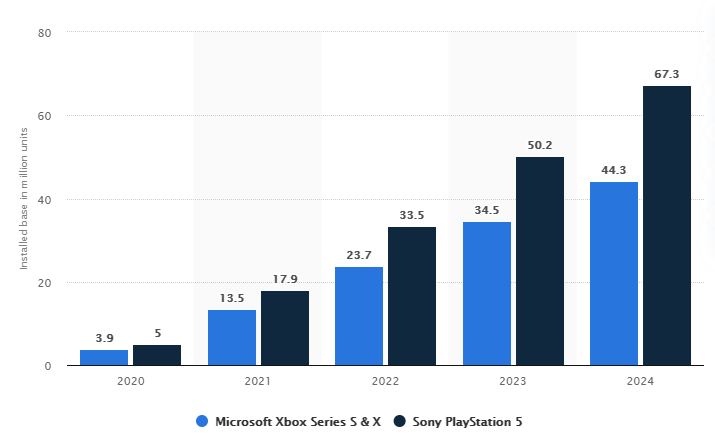Why try to beat the Lannister’s when you have the opportunity to be the iron bank? In this article, we highlight Sony’s excellent strategy to stay afloat in the streaming industry without offering a streaming service.
Key takeaways on Sony
- 2020 was Sony’s best year ever, with $9 billion of profit
- The company managed to thrive, in contrast with Japan which went from being a major world power in 1995 to stagnating since then.
- Sony is winning the console war, with 7.8 million PlayStation 5 unit sold vs. 5.8 million units for Microsoft’s Xbox Series X
- Sony decided not to join the streaming war, but to provide content to contenders instead, reaping massive profits without needing to invest for a platform.
Sony is thriving and leaving its country behind
Sony just had its best quarter in years, while Japan is having its worst quarter in years.
In the 1990s, or almost 30 years ago, America feared that Japan could overtake the American economy. Indeed, Japan’s $5.449 trillion GDP was not very far from the United States at $7.64 trillion. Japan was the only real competitor to the US, as China’s GDP was still way under the trillion dollars.
The land of the rising sun was flooding foreign markets with well-built products, such as Honda and Toyota for cars and motorbikes, or Sony for consumers electronics. The US honestly feared that their old enemy would simply take over. But the takeover never happened.
Trapped in an asset bubble followed by a deflationary trap, Japan’s economy failed to follow the same growth path as that of other developed countries. In fact, its economy was bigger in 1995 than it is today: Japan’s GDP is basically the same size as it was 30 years ago, whereas the US GDP tripled.
What about Sony?
In 1995, Sony was living the life: everybody wanted to own one of its Walkman to listen to music on the go – Apple was far from making the iPod – and many kids dreamed of acquiring the camera they saw in the Christmas movie “Home Alone”. The first generation of the Vaio, Sony’s personal computer, was in the making, set to come out in 1997.
After taking a solid hit during the dotcom bubble, the company managed to thrive thanks to its quality consumer electronics offering, while Japan lagged behind.
Today, the company keeps thriving as it records its greatest profit ever last year, with ¥1 trillion in profit (about $9 billion total and $8.5 per share). To put things into perspective, that is a little more that the Coca-Cola company, and a little less than Disney. Its stock is now at its highest level since the burst of the dotcom bubble.
Why might Sony have a solid position on the market right now?
The question to ask oneself is to which extent Sony’s market position is sustainable? There are two wars going on: the console war and the streaming war. Sony chose to fight one and supply for the second:
-
The PlayStation 5 vs. the Xbox One: who wins?
According to Sony, the PlayStation 5, its latest gen gaming console which came out last November, sold 7.8 million units so far. Is that good or is that bad? The best way to determine this would be to compare these sales with its directly competing product: Microsoft’s Xbox Series X.
While the company did not disclose their total number of sales, estimates range around 2 million units fewer. 2 million units ahead of one’s main competitor is not so bad in the gaming industry.
More recently, Sony invested in Discord as part of a $100 million funding round, planning for a close integration of the gaming chat service used by over 140 million gamers every month in their PlayStation environment. This is yet another argument for their fight in the console wars.

Sony's PlayStation 5 vs. Microsoft's Xbox Series S sales in million units (Source: Statista)
-
Sony does not fight in the streaming war: it provides weapons
Eyeing the dangerous battlefield, Sony chose not to join the streaming war. Instead, they opted to play the arms dealer’s role. The company owns the license of many popular franchises, such as Seinfeld, Spiderman, part of James Bond, Jumanji, Men in Black, and more.
They could have launched a streaming service called “Sony+” – is that not what you do when you want to get into streaming and have no good idea for a good name? – but it noticed that only one streaming service was making profits so far: Netflix.
The streaming war is a dangerous one, and more companies end up eating the mud than succeeding. Sony did not want to put in the years of work and hundreds of engineers on developing a streaming service. It was simply too many resources for the task, and it is even worse if they do not manage to win the war.
Having the rights to so many titles, all they had to do was licenses them to other streaming companies such as Netflix and Disney+ and cash in.
Sony can proudly show a $3 billion profit every year from streaming, and that’s pure profit. No costs of subscriber acquisition or maintaining a sophisticated platform. That is more than Netflix has made in profits ever, including the last tremendous year. Again, they are a streaming arms dealer making money out of their weapons of mass content. And that is not all: Sony also gets to premiere their movies in theatres and cash in some money there first, and then make 3 billion right behind it!
The lesson we can derive here is simple. If you are not in the mood to fight the Lannister’s, be the iron bank.





